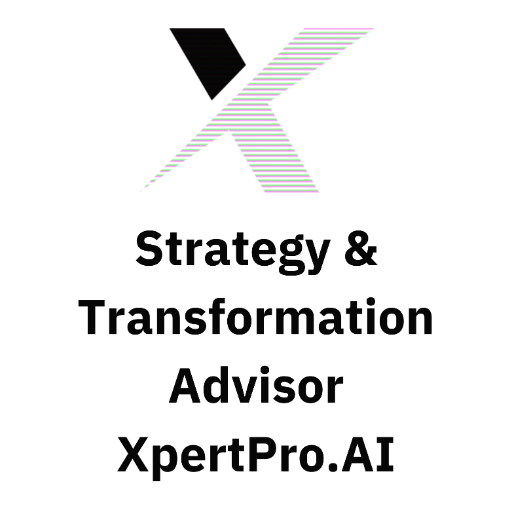Strategic Problem Solving Consulting-AI-driven problem solving
AI-powered solutions for your toughest problems
What problem do you want to solve?
What is the topic of your project?
How should I proceed with this project?
What are the opportunities for improvement?
Related Tools
Load More
Strategy
Use military strategy to solve problems you can't solve (Family disputes, workplace problems, etc.). Talk to me about your work or life problems.

Consulting Expert for Strategy and Transformation
A strategic guide for consultants with real-world business cases and enhanced AI knowledge

Strategy Consultant
I am strategy consulting expert, skilled in helping businesses conduct business diagnostics, identify existing problems, and analyze the root causes.

Business Strategy Consultant
Business strategy development tool to support you through a consulting process or strategy development process. The knowledge used is gathered from 20+ years in management consulting at global level.

Management Consultant
Management consultant with a McKinsey-like analysis and style.

Strategy & Transformation Advisor | XpertPro.AI
Navigating Futures: Your Compass for Strategic Transformation
20.0 / 5 (200 votes)
Introduction to Strategic Problem Solving Consulting
Strategic Problem Solving Consulting (SPSC) is designed to assist businesses and individuals in identifying, analyzing, and resolving complex issues through a structured approach. The core purpose of SPSC is to provide a systematic methodology for problem-solving that can be tailored to a wide range of scenarios, from operational inefficiencies to strategic planning challenges. By breaking down problems into manageable parts and exploring various solutions, SPSC helps clients achieve sustainable improvements and innovative outcomes. For example, a retail company facing declining sales might use SPSC to dissect the factors contributing to the downturn, such as market trends, customer preferences, or internal processes, and develop targeted strategies to address each aspect.

Main Functions of Strategic Problem Solving Consulting
Problem Identification and Analysis
Example
A manufacturing firm experiencing frequent production delays.
Scenario
SPSC helps the firm map out the entire production process, identifying bottlenecks and inefficiencies at each stage. By analyzing data and gathering insights from employees, SPSC pinpoints the root causes of the delays, such as equipment malfunctions or supply chain issues.
Solution Development
Example
A tech startup looking to improve its product development cycle.
Scenario
SPSC collaborates with the startup to brainstorm potential solutions, such as adopting agile methodologies or enhancing cross-functional communication. The consulting process includes evaluating the feasibility, costs, and benefits of each solution, ultimately recommending the most effective strategies.
Implementation and Monitoring
Example
A non-profit organization aiming to increase its fundraising effectiveness.
Scenario
SPSC assists the organization in implementing new fundraising strategies, such as digital campaigns or donor engagement programs. The consulting service also includes setting up key performance indicators (KPIs) and monitoring progress to ensure the strategies are delivering the desired results.
Ideal Users of Strategic Problem Solving Consulting Services
Small to Medium Enterprises (SMEs)
SMEs often face resource constraints and complex challenges that require tailored solutions. SPSC provides these businesses with structured problem-solving approaches, enabling them to optimize operations, enhance competitiveness, and drive growth. By leveraging SPSC's expertise, SMEs can address issues such as market positioning, operational efficiency, and customer satisfaction more effectively.
Non-Profit Organizations
Non-profits can benefit from SPSC's strategic approach to problem-solving to maximize their impact and efficiency. These organizations often operate with limited budgets and need to make every dollar count. SPSC helps non-profits identify areas for improvement, develop innovative solutions, and implement changes that lead to greater fundraising success, volunteer engagement, and mission fulfillment.

How to Use Strategic Problem Solving Consulting
1
Visit aichatonline.org for a free trial without login, also no need for ChatGPT Plus.
2
Describe your problem in detail to enable a thorough understanding of the issue.
3
Answer the three questions provided to gain a deeper insight into the problem's nature and scope.
4
Choose between a cause-seeking approach to improve existing systems or a creation approach to introduce new solutions.
5
Review the structured analysis and suggested solutions, select key areas for detailed solutions, and implement the chosen strategies.
Try other advanced and practical GPTs
Themenübersicht auf aiMOOC.org
AI-powered thematic overviews for learning

Looker Studio Helper
AI-powered assistant for Google Looker Studio

Hellscape: Backworld
AI-powered survival horror adventure.
Story and Keyword Based Article Copywriter by BV
AI-powered articles that rank

News Article Craft
AI-powered content creation made easy

Tamagui Docs
AI-powered Tamagui docs for coders.

Frozen Shoulder (Adhesive Capsulitis)
AI-powered recovery for frozen shoulder.

Protocol 1
Push Boundaries with AI-Powered Expertise

Crypto Guru 💎✋
AI-powered insights for crypto investments.

Laptops & Computers Ultimate Shopping Guide
AI-powered guide for perfect laptops.

FaceSwap
AI-Powered Face Swapping Made Easy

AGAPE LOVE
AI-powered biblical guidance for relationships

- Business Strategy
- Personal Development
- Innovation
- Process Improvement
- Operational Efficiency
Common Questions About Strategic Problem Solving Consulting
What types of problems can Strategic Problem Solving Consulting help with?
This tool can help with a wide range of problems, including business process improvements, strategic planning, operational efficiency, and innovation challenges.
How detailed should my problem description be?
The more detailed and specific your problem description, the better. This allows for a thorough analysis and more effective solutions.
What are the benefits of using the cause-seeking approach?
The cause-seeking approach helps identify and address underlying issues in existing processes, leading to long-term improvements and stability.
How does the creation problem approach work?
The creation problem approach focuses on generating new ideas and solutions to introduce innovative changes and improvements, enhancing growth and competitiveness.
Can Strategic Problem Solving Consulting be used for personal issues?
Yes, the tool is versatile and can be applied to personal development, productivity challenges, and other individual concerns.